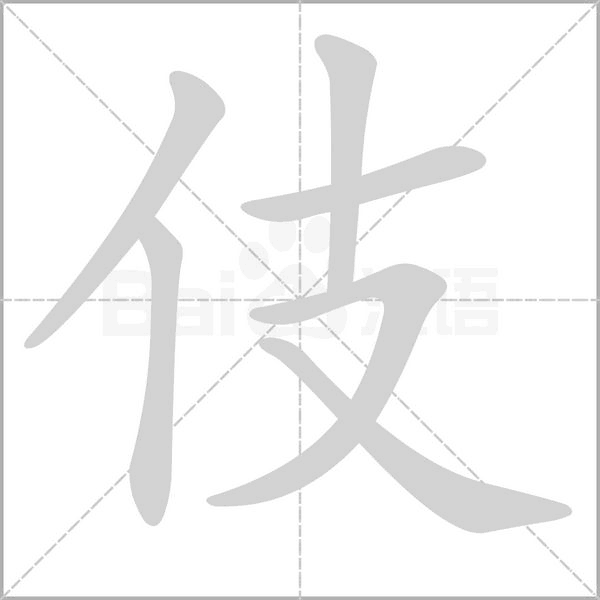详细解释
伎
1、(形声。从人,支声。本义:党与,同党的人)。
2、同本义。
伎,与也。---《说文》。段玉裁注:“《舁部》曰:‘与者,党与也。’此伎之本义也。”
3、歌女,舞女。
伎女楼上,坐而择食。---《洛阳伽蓝记》卷四城西
凄凉蜀故伎,来舞魏宫前。---刘禹锡《蜀先主庙》
伎人:女歌舞艺人
伎女:古代指女歌舞艺人。
4、泛指歌舞表演。
杂伎,艺以为珩。---张衡《思玄赋》。旧注:“手仗曰伎。”
伎船:以歌舞色相为业的游船
伎乐:古代俳优所奏的音乐
伎伎:形容奔走的样子。
5、技艺,本领。
无他伎。---《书·秦誓》
案谨募选阅材伎之士。---《荀子·王制》
故圣人之处世,不逆有伎能之士。---《淮南子·道应》
积财千万,不如薄伎在身。---《颜氏家训·勉学》
卜者,世之余伎也。---唐·柳宗元《非国语上·卜》
通天地而不通人曰伎。---《法言·君子》
伎痒:极想施展本领;动心
伎力:技能与勇力。
例句
歌舞伎中使用的语言很难理解,但是会提供耳机来解释故事的内容,还有英文解说服务。
The language of kabuki is difficult to understand, but earphones are provided to explain the story, and there are also earphone services available in English.
我们也想让更多人了解舞伎和艺伎。
We also wanted people to learn more about maiko and geisha.
日本的歌舞伎兴起于十七世纪中叶。
Kabuki appeared in the mid - seventeenth century in Japan.
你有一双歌舞伎一样的大眼睛。
You have the big, like, kabuki eye.
日本的歌舞伎兴起于十七世纪中叶。
Kabuki appeared in the mid-seventeenth century in Japan.
歌舞伎是日本民族引以自豪的传统戏剧。
Kabuki is proud of the Japanese nation traditional drama.
官伎与家伎,是六朝倡伎的两种主要类型。
Official and private singers and dancers are the two chief types.
歌舞伎演员身穿传统戏服,除了表演之外还要唱歌。
The kabuki actors wear traditional costumes, and sing in addition to acting.
歌舞伎和能剧一样是日本最有代表性的传统戏曲之一。
Kabuki and Noh in Japan as the most representative one of the traditional operas.
此时观众会喝彩,这时你将感受到歌舞伎的美妙之处。
At this point the audience will cheer and you will get caught up in the wonder of Kabuki!
歌舞伎中扮演女性角色的男演员被称作“oyama”。
Male actors that play the role of females are referred to as oyama.
另外,还将歌舞伎与同时代的浮世绘、艺妓进行了比较。
In addition, with the contemporary KabukiUkiyoe, geisha are compared.
独特的处理和头部形状的小型歌舞伎将便于联系起伏在途中。
The unique handle and head shape of our small kabuki will allow easy touch ups on-the-go.
歌舞伎是给普通人的,我也希望我的音乐也能是给每一个人的。
Kabuki is for the common people and I also want my music to be for everyone.
例如,我可以去看场歌舞伎剧场穿这样的衣服和去昂贵的餐厅和客户。
For instance, I can go to see a kabuki theater in these clothes and go to expensive restaurants with clients.
它们直观地展示了汉世乐舞伎人的风采,也揭示了他们的悲惨历史命运。
These Figs show directly the spirit of Han dancers, at the same time, reveal their tragic fate.
绳伎在清代由前代太常寺管理改为武备院管理,并由丝绳改为铜绳或麻绳。
The administration of rope-walking was transferred to the Wubei Department in the Qing Dynasty from the Taichang Monastery, the previous silk ropes was also changed to brass ropes or flax ropes.
酒店最著名的餐饮点是惠灵顿的歌舞伎,自2009以来举行的米其林星级。
The hotel's most famous dining spot is Kabuki Wellington , which has held a Michelin star since 2009.
怀着这样的想法而去面试牛郎的年轻人,光是歌舞伎町一年就超过了1万人!
With such ideas and to interview the young man, just a year kabuki parking more than 10000!
歌舞伎中消失自我介绍的原因在于:中日语言艺术的差别;剧本的长短问题。
The reasons for this singularity of Kabuki lie in the differences in the languages and the lengths of the respective genres.
文化方面则有歌舞伎、盆栽、相扑、茶道、和服和折纸,都源于日本独特的文化传统。
And there are culture practices such as KABUKI, BONSAI, SUMO, SADOU, KIMONO and ORIGAMI, all of which have developed into distinctly Japanese traditions.
弄清王紫稼的生卒年,对判定明清之际文人对男伎选择的具体进程有一定的参照意义。
It is important to clarify the years of wangs birth and death, which is useful for making judgement about the concrete process of scholar being close to Nanji.
在公元1610年阿国结束了舞台生涯,到那时截止, 已经有很多歌舞伎戏院的效仿者了。
Okuni retired around 1610 and by that time, there were many imitators of kabuki theatre.
她使用的竹笛叫做筱笛,是艺妓的基本“工具”之一,多用在日本能剧和歌舞伎剧场音乐之中。
It was a bamboo flute called a shinobue, much used in Noh and Kabuki theater music and part of the essential "kit" of the geisha.
她使用的竹笛叫做筱笛,是艺妓的基本“工具”之一,多用在日本能剧和歌舞伎剧场音乐之中。
It was a bamboo flute called a shinobue, much used in Noh and Kabuki theater music and part of the essential "kit" of the geisha.

